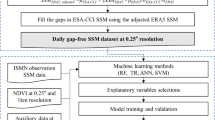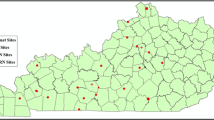Abstract
Remote sensing techniques have provided global covered soil moisture at high temporal resolution, however, the coarse spatial resolution and the data gaps have greatly reduced their potential values in large numbers of practical and regional applications. This study proposed a two-steps reconstruction approach for reconstructing satellite-based soil moisture products (ECV) at an improved spatial resolution. The reconstruction model implemented the Random Forests (RF) regression algorithm to simulate the relationships between soil moisture and environmental variables, and takes advantages of the high spatial resolution of optical remote sensing products: the data gaps of ECV soil moisture products were firstly filled by the estimation model trained using available pixels of the ECV products and corresponding environmental variables; then a spatial downscaling was carried out to the gap-filled ECV products to obtain the reconstructed soil moisture with fine spatial resolution (0.05°). As a result, the reconstructed soil moisture well fill the data gaps of the original ECV products and nicely reproduced the original soil moisture values (R2 > 0.98). The spatial resolution and variation details of the soil moisture products were also improved significantly. Validation results indicated that the reconstructed soil moisture showed comparable good performance (average R2 = 0.66) as the original ECV products (average R2 = 0.65) and nicely reflect the temporal behavior of ground-based measurements. As a result, the reconstructed soil moisture well filled the data gaps and greatly improved the spatial resolution of ECV products.







Similar content being viewed by others
References
Belgiu M, Drăguţ L (2016) Random forest in remote sensing: A review of applications and future directions. ISPRS J Photogramm Remote Sens 114:24–31
Breiman L (2001) Random Forests Machine Learning 45:5–32
Champagne C, McNairn H, Berg AA (2011) Monitoring agricultural soil moisture extremes in Canada using passive microwave remote sensing. Remote Sens of Environ 115:2434–2444
Champagne C, Berg AA, Mcnairn H, Drewitt G, Huffman T (2012) Evaluation of soil moisture extremes for agricultural productivity in the Canadian prairies. Agricultural & Forest Meteorology 165:1–11
Chauhan NS, Miller S, Ardanuy P (2003) Spaceborne soil moisture estimation at high resolution: a microwave-optical/IR synergistic approach. Int J Remote Sens 24:4599–4622
Coulibaly P, Evora ND (2007) Comparison of neural network methods for infilling missing daily weather records. J Hydrol 341:27–41. https://doi.org/10.1016/j.jhydrol.2007.04.020
Cui Y et al (2016) Validation and reconstruction of FY-3B/MWRI soil moisture using an artificial neural network based on reconstructed MODIS optical products over the Tibetan Plateau. J Hydrol 543:242–254. https://doi.org/10.1016/j.jhydrol.2016.10.005
Dorigo W, de Jeu R (2016) Satellite soil moisture for advancing our understanding of earth system processes and climate change. Int J Appl Earth Obs Geoinf 48:1–4. https://doi.org/10.1016/j.jag.2016.02.007
Dorigo W et al (2017) ESA CCI Soil Moisture for improved Earth system understanding: State-of-the art and future directions. Remote Sens Environ. https://doi.org/10.1016/j.rse.2017.07.001
Fang L, Hain CR, Zhan X, Anderson MC (2016) An inter-comparison of soil moisture data products from satellite remote sensing and a land surface model. Int J Appl Earth Obs Geoinf 48:37–50. https://doi.org/10.1016/j.jag.2015.10.006
Fern N-DM, Cernadas E, Barro S, Amorim D (2014) Do we need hundreds of classifiers to solve real world classification problems? J Mach Learn Res 15:3133–3181
Im J, Park S, Rhee J, Baik J, Choi M (2016) Downscaling of AMSR-E soil moisture with MODIS products using machine learning approaches. Environ Earth Sci:75–1120
Immerzeel WW, Rutten MM, Droogers P (2009) Spatial downscaling of TRMM precipitation using vegetative response on the Iberian Peninsula. Remote Sens Environ 113:362–370
Jia S, Zhu W, Lű A, Yan T (2011) A statistical spatial downscaling algorithm of TRMM precipitation based on NDVI and DEM in the Qaidam Basin of China. Remote Sens Environ 115:3069–3079
Jing W, Yang Y, Yue X, Zhao X (2016) A Comparison of Different Regression Algorithms for Downscaling Monthly Satellite-Based Precipitation over North China. Remote Sens 8:835. https://doi.org/10.3390/rs8100835
Kerr YH et al (2012) The SMOS Soil Moisture Retrieval Algorithm. IEEE Trans Geosci Remote Sens 50:1384–1403. https://doi.org/10.1109/TGRS.2012.2184548
Kerr YH et al (2010) The SMOS Mission: New Tool for Monitoring Key Elements ofthe Global Water Cycle. Proc IEEE 98:666–687. https://doi.org/10.1109/JPROC.2010.2043032
Koike T, Nakamura Y, Kaihotsu I, Davaa G, Matsuura N, Tamagawa K, Fujii H (2004) Development of an advanced microwave scanning radiometer (AMSR-E) Algorithm for soil moisture and vegetation water content. Doboku Gakkai Ronbunshuu B 48:217–222
Liu YY et al (2011) Developing an improved soil moisture dataset by blending passive and active microwave satellite-based retrievals. Hydrol Earth Syst Sci 15:425–436. https://doi.org/10.5194/hess-15-425-2011
Long D et al (2014) Drought and flood monitoring for a large karst plateau in Southwest China using extended GRACE data. Remote Sens Environ 155:145–160. https://doi.org/10.1016/j.rse.2014.08.006
Mccabe MF, Wood EF, Wójcik R, Pan M, Sheffield J, Gao H, Su H (2008) Hydrological consistency using multi-sensor remote sensing data for water and energy cycle studies. Remote Sens Environ 112:430–444
Moore ID, Gessler P, Nielsen G, Peterson G (1993) Soil attribute prediction using terrain analysis. Soil Sci Soc Am J 57:443–452
Naeimi V, Scipal K, Bartalis Z, Hasenauer S, Wagner W (2009) An Improved Soil Moisture Retrieval Algorithm for ERS and METOP Scatterometer Observations. IEEE Trans Geosci Remote Sens 47:1999–2013. https://doi.org/10.1109/TGRS.2008.2011617
Pal M (2005) Random forest classifier for remote sensing classification. Int J Remote Sens 26:217–222
Peng J, Loew A, Merlin O, Verhoest NEC (2017) A review of spatial downscaling of satellite remotely sensed soil moisture. Rev Geophys 55:341–366. https://doi.org/10.1002/2016rg000543
Peng J, Niesel J, Loew A, Zhang S, Wang J (2015) Evaluation of Satellite and Reanalysis Soil Moisture Products over Southwest China Using Ground-Based Measurements. Remote Sens 7:15729–15747. https://doi.org/10.3390/rs71115729
Petropoulos G, Carlson TN, Wooster MJ, Islam S (2009) A review of Ts/VI remote sensing based methods for the retrieval of land surface energy fluxes and soil surface moisture. Prog Phys Geogr 33:224–250
Piles M et al (2011a) Downscaling SMOS-Derived Soil Moisture Using MODIS Visible/Infrared Data. IEEE Transactions on Geoscience & Remote Sensing 49:3156–3166
Piles M et al (2011b) Downscaling SMOS-Derived Soil Moisture Using MODIS Visible/Infrared Data. IEEE Trans Geosci Remote Sens 49:3156–3166. https://doi.org/10.1109/tgrs.2011.2120615
Piles M, Entekhabi D, Camps A (2009) A Change Detection Algorithm for Retrieving High-Resolution Soil Moisture From SMAP Radar and Radiometer Observations. IEEE Transactions on Geoscience & Remote Sensing 47:4125–4131
Qiu J, Gao Q, Wang S, Su Z (2016) Comparison of temporal trends from multiple soil moisture data sets and precipitation: The implication of irrigation on regional soil moisture trend. Int J Appl Earth Obs Geoinf 48:17–27. https://doi.org/10.1016/j.jag.2015.11.012
Ray RL, Jacobs JM, Cosh MH (2010) Landslide susceptibility mapping using downscaled AMSR-E soil moisture: A case study from Cleveland Corral, California, US Remote. Sensing of Environment 114:2624–2636. https://doi.org/10.1016/j.rse.2010.05.033
Sheffield J, Wood EF (2008) Global Trends and Variability in Soil Moisture and Drought Characteristics, 1950-2000, from Observation-Driven Simulations of the Terrestrial Hydrologic Cycle. J Clim 21:432–458. https://doi.org/10.1175/2007jcli1822.1
Srivastava PK, Han D, Ramirez MR, Islam T (2013) Machine Learning Techniques for Downscaling SMOS Satellite Soil Moisture Using MODIS Land Surface Temperature for Hydrological Application. Water Resour Manag 27:3127–3144. https://doi.org/10.1007/s11269-013-0337-9
Temimi M, Lacava T, Lakhankar T, Tramutoli V, Ghedira H, Ata R, Khanbilvardi R (2011) A multi-temporal analysis of AMSR-E data for flood and discharge monitoring during the 2008 flood in Iowa. Hydrol Process 25:2623–2634
Zhao W, Li A (2013) A Downscaling Method for Improving the Spatial Resolution of AMSR-E Derived Soil Moisture Product Based on MSG-SEVIRI Data. Remote Sens 5:6790–6811
Acknowledgments
This study were jointly supported by the GDAS’ Special Project of Science and Technology Development (2017GDASCX-0101, 2018GDASCX-0904), the Guangdong Innovative and Entrepreneurial Research Team Program (2016ZT06D336), the National Natural Science Foundation of China (41601175, 41401430), and the National Earth System Science Data Sharing Infrastructure (http://www.geodata.cn/).
Author information
Authors and Affiliations
Corresponding author
Rights and permissions
About this article
Cite this article
Jing, W., Zhang, P. & Zhao, X. Reconstructing Monthly ECV Global Soil Moisture with an Improved Spatial Resolution. Water Resour Manage 32, 2523–2537 (2018). https://doi.org/10.1007/s11269-018-1944-2
Received:
Accepted:
Published:
Issue Date:
DOI: https://doi.org/10.1007/s11269-018-1944-2




